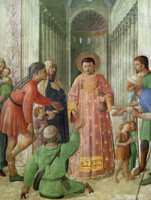
One cannot have a blog called Catholic Deacon and pass the Feast of St. Lawrence with no comment. St. Laurence, from the introduction to his feast in the Liturgy of the Hours, "was one of the seven deacons of the Church of Rome and was executed on 10th August 258, four days after [Pope] Sixtus II and his companions. By now, few of the facts of his life are known for certain: he was probably a Spaniard from Toledo. A basilica was built over Laurence’s tomb fifty years after his death, by the Emperor Constantine, and the anniversary of his martyrdom was kept as a solemn feast – with considerably more solemnity than that of Pope Sixtus II (we do not know why). By the sixth century, it was one of the most important feasts throughout much of western Christendom. His name occurs (with Sixtus’s) in the Roman Canon of the Mass."
It bears mentioning again that St. Lawerence was a deacon, a man ordained for nothing but service diakonia. He, along with many of the Roman clergy, including the Pope, was a victim of the Valerian persecution. At the beginning of August in the year 258, the emperor Valerian issued an edict commanding that all bishops, priests, and deacons should immediately be put to death ("episcopi et presbyteriet diacones incontinenti animadvertantur" -- Cyprian, Epist. lxxx, 1). Lawrence was in charge of all the Church of Rome's temporal goods. According to legends of his martyrdom, after being captured by the emperor's soldiers, St. Lawrence was given two days to bring all the treasures to the imperial palace, under penalty of death. Lawrence gathered up the all the diseased, orphaned or crippled Christians, brought them to the palace, and told the startled emperor, "These are the treasures of the church!"
The psalter for Evening prayer this evening begins with Psalm 116, 1-9, which reads: " I was caught by the cords of death; the snares of Sheol had seized me; I felt agony and dread. Then I called on the name of the LORD, 'O LORD, save my life!' Gracious is the LORD and just; yes, our God is merciful. The LORD protects the simple; I was helpless, but God saved me" (4-6). Indeed, the Lord save St. Lawrence who gave his life, in imitation of Jesus Christ, not only in his death, but in his life of service to the Christians of Rome.
It is hard to over emphasize San Lorenzo's importance to the Church of Rome. His Church, known as San Lorenzo fuori le Mura — Saint Lawrence outside the Walls — is one of the most important basilica churches and one of the Seven Pilgrim Churches of Rome. As such it is a station Church during Lent. The Basilica was built in the 4th century over St. Lawrence's tomb by digging into the catacomb in which he was buried and isolating his shrine so that a church could be built around it. The basilica was restored by Pope Pelagius II (579-590). Pelagius' restored church has been preserved as part of the current structure as the part of the church beyond the altar.
The basilica is the shrine tomb of the church's namesake, Saint Lawrence. Pope Pius IX, awaiting canonization into sainthood, is also buried at the basilica. Italian Prime Minister Alcide De Gasperi, a founding father of the European Union also rests in the basilica.
Pray for your deacons, men who, like Lawrence, are ordained for service.


No comments:
Post a Comment